
 |
|||||
|
|
|||||
|
|
|
|||||
|
|
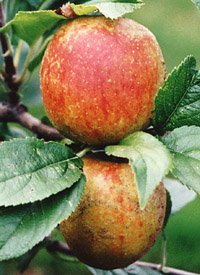 |
HUBBARD’S PEARMAIN An eighteenth century apple, introduced by Lindley in 1820 at a meeting of the London Horticultural Society as ‘a real Norfolk apple’. Small fruit, with yellow-green skin, flushed bronze-red, and sometimes russeted. The flesh is firm, crunchy and juicy with a very rich flavour - Hogg clearly thought highly of it, saying that no English apple was its superior. Pretty white blossom, and good crops. A late apple ripe in October and storing until January. Pollination Group 4 |
||
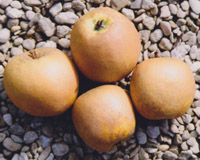 |
HUNT’S DUKE OF GLOUCESTER Raised by Dr. Fry of Gloucester and introduced by Thomas Hunt in 1820. A mid season dessert and cider apple, small to medium sized, round and conical, with golden skin, lightly russeted. At the end of September the apples are crisp, but yielding, juicy, very sweet and with a very lemony, zesty, rich flavour. An excellent and powerful apple, storing to January. Pollination Group 3 |
|||
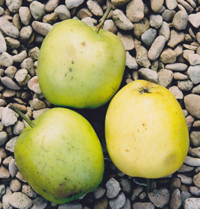 |
IBSTONE
PIPPIN An old and previously unknown variety introduced to us
by Tom and Susan White of Pishill Bottom, Stonor, near Henley, Oxfordshire
in 2013. Their tree was probably planted by Tom’s father around
1940. His mother came from nearby Ibstone, which was probably the source
of their tree. Since their tree suckers and the fruit is the same on the
suckers, their tree cannot have been grafted and it is assumed to be a
‘Burr Knot’ type which will root easily from cuttings, and
therefore is easily passed around from place to place. It is a medium
sized oblong apple, green turning pale yellow, and ripe in late August,
when it is crisp, juicy sweet and with a good flavour. By late September/early
October it has become soft with a peculiar musty taste. A good early eating
apple, and probably a useful sweet cider apple. Pollination Group 5 |
|||
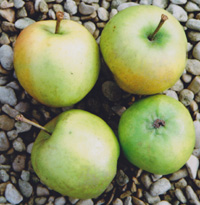 |
ICKFORD
RUSSET We recently returned to the large old orchard, attached
to the 17th century thatched house, which we had investigated many years
earlier with the late Mrs Story, at the oldest part of Little Ickford,
just in Buckinghamshire but very close to Oxfordshire. Mrs Story’s
daughters, Clare and Jo, met us there and we were able to offer some variety
names revealed by dna profiling. Three very old trees had unmatched DNA
and have now been included in this catalogue. Strawberry Queen and Thomas
Tipping are the others. This medium sized, green becoming golden russet
in Clare’s orchard is ripe in October or early November and will
last beyond the year end. The level of russeting is variable. A crisp
and juicy eating apple with a good flavour, sweetness and enough acid.
Clare has named it “Ickford Russet”. Pollination Group 4 |
|||
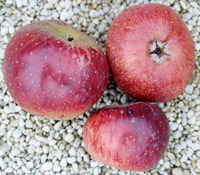 |
IFFLEY BEEFING A good old-fashioned cooker, introduced to us by Mr and Mrs Grimley-Evans of Iffley, a village near Oxford on the River Isis, now a suburb of Oxford. Their farmhouse, on the edge of the village, still retained two old trees from the old farm orchard. It was still a remote, active farm at the beginning of the 20th century. A tall tree bore large apples, of such a density that they don’t bruise when dropping from a great height. They are flat and broad with a wide, open eye in a flat basin. The skin is pinky red, almost all covered with deep red and striped maroon. There is heavy russet around the stalk and there are prominent white dots over the body. It is pleasantly edible as a dessert apple when fully ripe but primarily it is of culinary use, with a very good, tangy, yet sweet, flavour. When cooked the dark skin colours the flesh with pink. It keeps some shape. When cut, it does not discolour or bruise readily. It becomes ripe in early October and will store until the end of the year, at least. It is not obviously any variety still known and has been renamed Iffley Beefing to send it on a new life of popularity. Mr and Mrs Grimley-Evans have also provided Iffley Codlin, below. Pollination Group 4 | |||
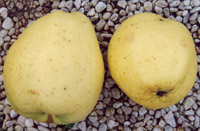 |
IFFLEY CODLIN As with Iffley Beefing, given to us by Corrine and John Grimley Evans of Iffley, Oxford. This is an old tree, but not of large growth. There were once many different codlins, but few now exist in collections and it may be difficult to identify its original name, hence its new name of Iffley Codlin. It is medium sized, oval and conical in shape, lightly ribbed on the body and more prominently at the eye. There are some dark dots on the skin, but it is otherwise of uniform green, going pale golden with full ripeness. In common with other old codlins, it can be used quite early – as early as August, while the fruit is produced over a period into October, when it is crisp, juicy, becoming sweeter - and then a very pleasant eating apple. Its best use, though, is culinary. If used early it keeps its shape when cooked, producing clear, cream flesh and having a very rich tangy and sweet flavour, useful in tarts. By September it will keep some shape but would mash. The flavour is very rich and lemony without the need for added sugar. The apple is now sweet enough to eat with pleasure. Apples will store into November. Pollination Group 3
|
|||
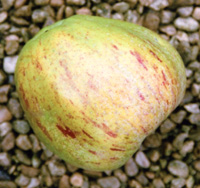 |
IMBER COSTARD For a full account of the Costard, one of our very oldest apples, please see our website. The Costard has seemingly been long lost, but surely there are still survivors somewhere. This is one possibility. One of the truly great and one of the very few authoritative writers on gardening of his age was The Reverend William Hanbury of Church-Langton, Leicestershire. His ‘A Complete Body of Planting and Gardening...’ in 1770, was written from real experience, rather than from repeating the already repeated words of others. He set up plant nurseries in his area and used the proceeds exclusively for improvements locally - notably the Church and a new school. His descriptions of apples could not have been written without great familiarity with them. His varieties hark back to names known in the 17th century or early 18th, rather than new names that were becoming known late in the 18th century. He included the Costard! It “Is a large, irregular Apple, finely striped with red, especially on the sunny side. The flesh is tender and juicy, but not very agreeable to the palate. This Apple is in universal request for baking, and affords the best sauce yet known for a goose, roast pork, and the like savoury meats.” Though earlier accounts of the Costard said it was green, grey, even red, suggesting a class of apples rather than a single variety, this is the first reference to a striped apple - perhaps having mutated slightly, as apples are prone to do. Dr Suzie Imber is a planetary astrophysicist at Leicester University, While living at East Langton, Leicestershire (the next village to Church Langton) she bought a very old orchard nearby, to ensure its future as an orchard and for the pleasure of tending it. The area is of great antiquity. Suzie and her parents called on us to ask what we could tell them about the variety of apples they brought, a few years back. We then visited Suzie, the area and her friend Mark Newton who now owns Hanbury's rectory at Church Langton. The Rev. William Hanbury, as we detailed above, set up several plant and fruit tree nurseries around the Langtons in the mid 18th century. Suzie's very old trees were likely to have come from the Hanbury pool. One, called the Lightning Tree by her, could fit the bill of Hanbury’s Costard. Before a lightning strike the tree was around 50ft tall, but is now around 35ft. William Lawson in ‘A New Orchard and Garden’, of 1597-1618, said “Of your apple-trees you shall find a difference in the growth. A good pippin will grow large, and a Costard Tree", and this tree is certainly vigorous and very, very old. Its DNA has not been matched with any other tested known variety. Hanbury’s description fits this apple prefectly (though caution says it might fit others). We would say that the apple is pleasant enough to eat raw, when fully ripe, but otherwise the fit is complete. The flesh is cream to pale green, green along the core line. It slowly discolours when cut, but not so much as some. The apple is fairly weighty and the flesh is not over juicy, of an open texture, firm rather than crisp. Pleasantly sweet and with a fair flavour, a little of lemon. Fine to eat but not the best. Cooked, it softens very quickly and goes to a mashable puree consistency. The flavour is very much enhanced and it has all the right elements, perfectly balanced. The flavour is quite complex, and very good indeed; very rich and needing no added sugar. The flesh has gone yellow after cooking. The apples will last into the New Year as do the old Costards. This apple has a legitimate claim to be the Costard of Hanbury or the ancient Costard if these are the same. It might be the Costard of Parkinson (1629), if that had undergone some mutation to introduce stripes, but the Gray and the Greene Costards of Parkinson might have other claimants. Pollination Group ? |
|||
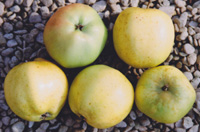 |
IMPROVED KESWICK CODLIN An old apple that was thought to have been lost, but we found an old tree in 2006, along with several other important fruits, in the orchard of the late Martin Stevens at Holmer Green in Buckinghamshire. Born in 1920, he was involved with orchards from childhood (as were his father and grandfather) and he remembered all the names of his trees and relayed them to us. The origin and age of this variety is uncertain and it is still unknown whether it was a seedling of Keswick Codlin or a mutation. The first known record was when it was exhibited by Harrison Nurseries of Leicester, at the 1883 National Apple Congress, held at the RHS grounds at Chiswick. It was said to be later season, more rounded than Keswick Codlin and pale straw coloured. It was also described as being acid, but that might be due to the early collection of apples for exhibit, as ours is actually quite sweet. Evans and Martin (2014) have suggested the origin to be at Harrowbarrow, Callington, Cornwall, while Thornhayes Nursery have said it was from the Tamar Valley, a little further south, but we do not know what records they draw from or the source of their fruit, which seems a little different from ours. Martin Stevens informed us that his Improved Keswick Codlin was paler, more rounded, lasted longer and was a little larger. That has been our experience here. Ripe at the end of September, when cooked it keeps its shape partially, softens fairly quickly and is very fruity but not so tangy. It is sweet enough without the addition of sugar. By the end of November the apples have become sweet enough to eat raw and stay in good condition to end of the year. Pollination Group 4 |
|||
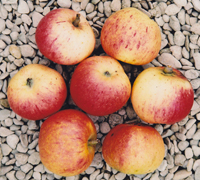 |
IRISH
PEACH One of the best early apples, sent to the London Horticultural
Society in 1819. It was very popular in Victorian and Edwardian times
as 'a beautiful dish for dessert '. It is best eaten when fresh, as it
does not store long before the rich, crisp and juicy flesh declines. The
trees are moderately vigorous and spreading, and are tip bearing. Good
crops, ready to pick in August or early September. Attractive pink blossom.
Pollination Group 2 |
|||
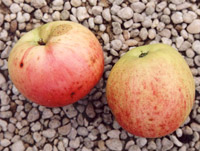 |
ISLAY
PIPPIN Possibly the ‘Lord Islay’s Pippin’ of
Forsyth. He mentioned the apple in 1810, but no further record of it existed.
The otherwise excellent 1971 National Apple Register, written by Muriel
Smith, did not include the work of Forsyth, relying instead upon reports
from him by Lindley and Hogg, who clearly had no knowledge of this apple.
We noticed that the Grove Research Station in Tasmania had an Islay Pippin,
a name we had not discovered in any other world collections, and assumed
it possibly to be the same as Lord Islay’s Pippin. Lord Islay became
3rd Duke of Argyll when his brother, the second duke, died. The 2nd duke,
a very keen horticulturalist, created a house and garden at Whitton Park,
Hounslow. Whether Lord Islay’s Pippin belonged to the second or
third duke is unclear but on the death of the 3rd duke in 1761, many of
the exotic plants were transferred to the Royal Gardens at Kew. This was
the province of Forsyth (Gardener to George III) and he would surely have
come across the apple, if our speculations are correct. The assumption
must be that this is a London apple not a Western Isles apple. Forsyth
only lists the apple - there is no description. Whatever it is, it is
a delicious early season apple, with attractive pale skin, delicately
striped red and with sweet and crisp lemony flesh. Spur bearing. We have
noticed that others have taken this apple from us and called it Lord Islay’s
Pippin. In the absence of firm evidence to conclude that it is the apple
of Forsyth, it should be called Islay Pippin. Pollination Group 4 |
|||
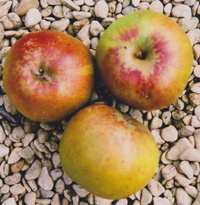 |
ISLE OF WIGHT PIPPIN This, possibly 17th century, excellent apple was sold by Deacons Nursery on the Isle of Wight for several years and matches the old descriptions. The National Collection at Brogdale listed it in their collection but removed it after the 1980s, because they did not belive it matched published descriptions. It seems to have resided only on the Isle of Wight in modern times. The best description comes from Geoge Lindley in 1831 under the name Orange Pippin, with a synonym of Isle of Wight Pippin, but the latter name was used earlier. He said “Fruit middle sized, globular. Eye but little sunk, with broad, acute segments of the calyx. Stalk very short. Skin a yellowish golden grey, with a russety epidermis, highly coloured with orange and red on the sunny side. Specific Gravity of the juice 1074. This very beautiful apple is cultivated in Herefordshire, both as a dessert and cider apple. Its yellow pulp communicates a fine golden tinge to the juice of other varieties, and it is of itself an excellent cider fruit. Its name has originated, no doubt, from the appearance of its fruit when highly ripened, resembling that of a crop of very ripe Seville oranges. There are trees now to be found 100 years old; but where it originated cannot be ascertained. It has been supposed by some that the Orange Pippin was brought from Normandy to the Isle of Wight and that the first of the kind was planted in the garden of Wraxhall Cottage, near the under cliff, where it was growing in 1817.” Hogg in 1884 said that it was Thomas Andrew Knight who conveyed the suggestion of others that it came from Normandy and also that it was Wrexhall, not Wraxhall Cottage. Otherwise he followed Lindley’s description. There are other Orange Pippins that have been known and an apple still goes by that name in the West Country, which might or might not be the same as this. IOW Pippin is ripe in late October, when it is sweet, richly flavoured and very juicy. It does not seem to last more than a month or two. Pollination Group 4 |
|||
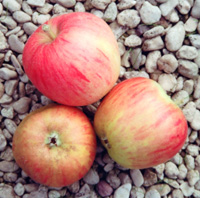 |
ISLE
OF WIGHT RUSSET An apple without much known history that was
sold by the former Deacon’s Nursery on the Isle of Wight. A variety
that seems to be a very precocious bearer and a very good mid-season apple.
Ripe in late August to mid September, the apples are rounded, lightly
russeted and prettily striped. It is a good apple, with a well rounded
flavour, sweet, lemony, juicy and crunchy. It lasts for only a month,
but is very good while it lasts. Pollination Group 6 |
|||
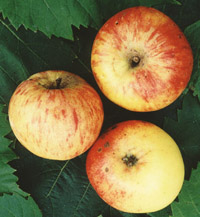 |
JAMES GRIEVE James Grieve was the manager of Dickson’s Nurseries, of Edinburgh. He introduced this mid-season, dual-purpose apple in 1893. Considered by some to be a cooker when grown in the north and dessert when grown in the south, we find it is a good cooking apple in both places, but remains only a mediocre dessert apple in the south. When eaten for dessert the fruit is crisp and juicy, with an unremarkable flavour; cooked it keeps all shape, but would mash. It can go a little dry after cooking, and is somewhat sharp and might want sugar, but is very rich and tangy. Still popular in Scotland, the tree is hardy, crops well and has striking pink and white blossom. It is ripe in mid-September and stores until November. Pollination Group 4 | |||
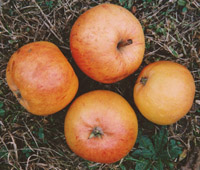 |
JENNIFER
It was raised in 1923 by nurseryman F.W. Wastie of Eynsham, Oxfordshire
and recorded in 1944, when it was sent to the National Fruit Trials by
his son, J.F. Wastie, who named it after his daughter. A cross between
Duchess’s Favourite and Beauty of Bath. It is an early dessert apple,
ready in late August and early September. The apples are slightly ribbed
with yellow skin, flushed pale red and striped with bright red. A sweet,
crsip and juicy apple, but does not keep long. A vigorous grower. Part
tip bearing. Pollination Group 3 |
|||
|
||||